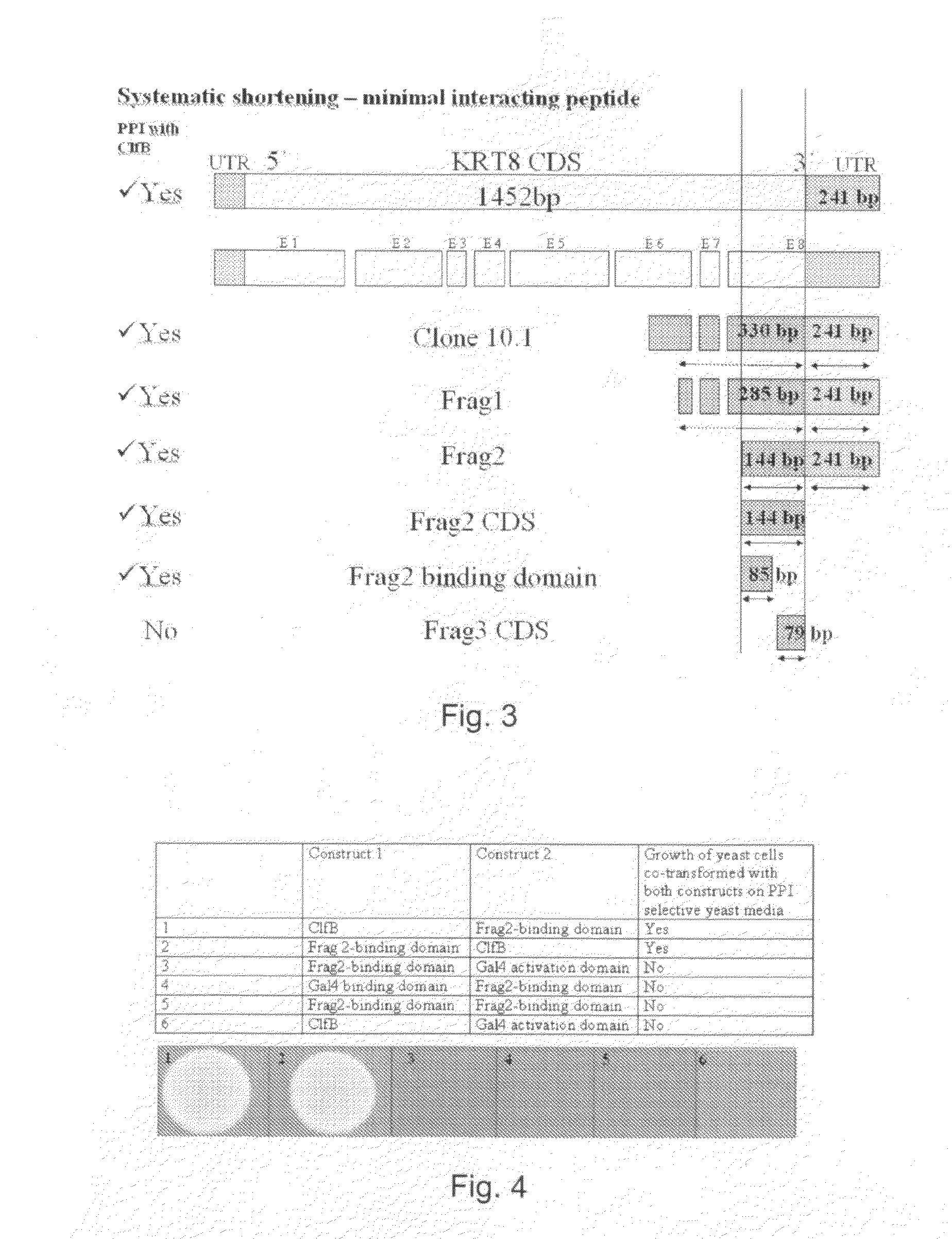Method for Manufacturing a Modified Peptide
- Summary
- Abstract
- Description
- Claims
- Application Information
AI Technical Summary
Benefits of technology
Problems solved by technology
Method used
Image
Examples
example 1
Initial Y2H-Screenings with S. aureus Virulence Factors
[0144]1.1. Primary Y2H-PPI Hits
[0145]A Y2H-screen with the virulence factors of S. aureus (clumping factor b (ClfB)), fibronectin binding protein (Fnbp), Elastin binding protein (EbpS), and Collagen binding protein (CNA) was initiated.
[0146]Two different Y2H-screening libraries were used for this purpose, a genomic library of S. aureus and a cDNA library of human keratinocytes. Both libraries were house-made by general library cloning strategies.
[0147]ClfB and FnbB were screened against the human cDNA library, whereas EbpS and CNA were screened against the S. aureus genomic library.
[0148]Each screen was performed separately and resulted in “positive Y2H colonies”. Positive Y2H colonies are yeast colonies, which contain a pair of plasmids encoding for proteins or protein fragments that can interact with each other. Interacting pairs of proteins or protein fragments can turn on a reporter gene. The reporter gene is a gene, which i...
example 2
Construction of an ORFeome Exemplified by the ORFeome of S. aureus
[0157]The sum of all open reading frames (ORFs) of all annotated genes from a given organism is called an ORFeome. By systematic cloning of an ORFeome one can construct a complete collection of genes for organism-wide research. The ORFeome is a resource. The construction of an ORFeome is a challenging undertaking, because each gene has to be amplified from a cDNA or genomic-DNA source with specific primers (e.g. for S. aureus about 6000 primers are needed) and has to be cloned one by one into plasmids. However, it enables a more comprehensive and systematic research because each gene's role (more precisely also each protein's role produced from a certain gene) is investigated in one experiment and no gene is skipped. Furthermore, there is no bias due to unequal representation of expressed genes as it is in cDNA-libraries (low abundant or high abundant expressed genes). If libraries are made from the ORFeome, one can ...
example 3
Libraries of Pooled ORFeome
[0177]The aim was to construct a comprehensive and normalized Y2H-library, which contains all genes from an organism and is unique in composition[0178]Equal amounts of pure plasmids from each of the 2623 DNA-preparations were mixed each containing a specific ORF from S. aureus. See parts 6.1 and 6.2 for ORFeome cloning for the DNA-preparations used.[0179]The resulting pooled library is completely different from existing gene-libraries because the content of the existing genes is exactly known. Additionally, standard libraries are not guaranteed to contain complete genes; in fact they often contain gene fragments, non-coding regions such as 5-primed and 3-primed untranslated regions, and are to a large extend out-of frame for the gene.[0180]Additionally, we mixed equal amounts of living E. coli cultures each containing the 2623 different S. aureus ORFs.[0181]The titre of colony-forming units in the mixed E. coli culture stock was calculated and the volume w...
PUM
| Property | Measurement | Unit |
|---|---|---|
| Time | aaaaa | aaaaa |
| Transport properties | aaaaa | aaaaa |
Abstract
Description
Claims
Application Information
 Login to View More
Login to View More - R&D
- Intellectual Property
- Life Sciences
- Materials
- Tech Scout
- Unparalleled Data Quality
- Higher Quality Content
- 60% Fewer Hallucinations
Browse by: Latest US Patents, China's latest patents, Technical Efficacy Thesaurus, Application Domain, Technology Topic, Popular Technical Reports.
© 2025 PatSnap. All rights reserved.Legal|Privacy policy|Modern Slavery Act Transparency Statement|Sitemap|About US| Contact US: help@patsnap.com



